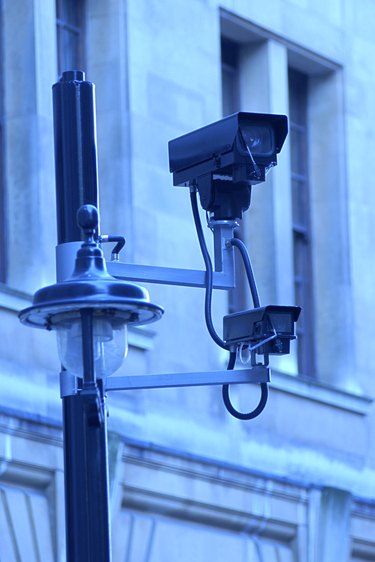 Photocells on security lights turn the lights on automatically at dusk. Image Credit: Thinkstock Images/Comstock/Getty Images
Photocells on security lights turn the lights on automatically at dusk. Image Credit: Thinkstock Images/Comstock/Getty Images
Photocells used in outdoor security lighting switch the lights on at dusk and off at dawn. A photocell is sensitive to light and converts light that falls on its surface to electrical current. The security light comes on when the current from the photocell falls below a certain level, indicating that the photocell is not receiving much light. Security lights can malfunction if poorly adjusted or if a light has defective circuits.
Video of the Day
Extraneous Light
The most common problem encountered with security lights controlled by photocells is that they shut off unexpectedly during the night. This can be the result of light falling on the photocell and increasing its output current to a level interpreted as daylight. This light may come from other lighting in the area, or light can reflect back to the photocell from the security light itself. To test whether the fixture is affected by this issue, place electrician's tape over the photocell; if the security light stays on, shading the photocell from extraneous light will result in a permanent fix.
Dust and Shading
Another problem with security lighting is that the light remains on during the day. This means the photocell is not getting enough light; the current output of the cell corresponds to nighttime and the security light stays on. Dust may have accumulated on the photocell, or it may be shaded by some recently installed object. Often, the photocell is located behind a transparent panel that clouds with age. Cleaning the area around the photocell and wiping dust from the transparent panel will ensure that daylight reaches the cell and solve this problem.
Electrical
Some security lighting is controlled by a separate photocell unit that plugs into the light. It may be mounted separately and wired into the security light. In either case, electrical connections can fail, causing the security light to not turn on. If terminals are exposed, a multimeter can be used to measure resistance from the photocell circuits to the light and confirm that the connections are good. Sometimes a wire has worked loose or a connector is defective. The electric current to switch on the light must pass through the photocell switch, and if those connections are bad, the light will not operate.
Incorrect Settings
Most security lights have small dials or screws that enable the user to set the light level that turns the fixture on and off. If a photocell's characteristics have changed with age or if the settings have been changed inadvertently, the security light may not turn on or off. Refer to the owner's manual for instructions on the correct settings. Typically, one or two dials or screws can be adjusted to increase or decrease the photocell's light sensitivity. If you don't have a manual, you can usually ascertain the desired behavior by adjusting the settings at dusk.


